Dr. Shirley's Bio
If you want my spiritual journey, go here.
I'm mixed British - Welsh, Scots, English, and named for a street in Cardiff, the capital city of Wales.
From Cardiff and Penarth, my family moved to Stratford-on-Avon, the home town of Shakespeare.
Shortly before WWII we moved to Coventry, where we lived through the Blitz. After that, we moved to Barnoldswick, on the Yorkshire/Lancashire border, where Frank Whittle was developing the first jet aero-engines.
Dad had been a pilot in WWI, and was an engineer as well as an artist.
He was too old to fly again, so he joined the ground-crew.
Visit : Cardiff | Yorkshire | Barnoldswick
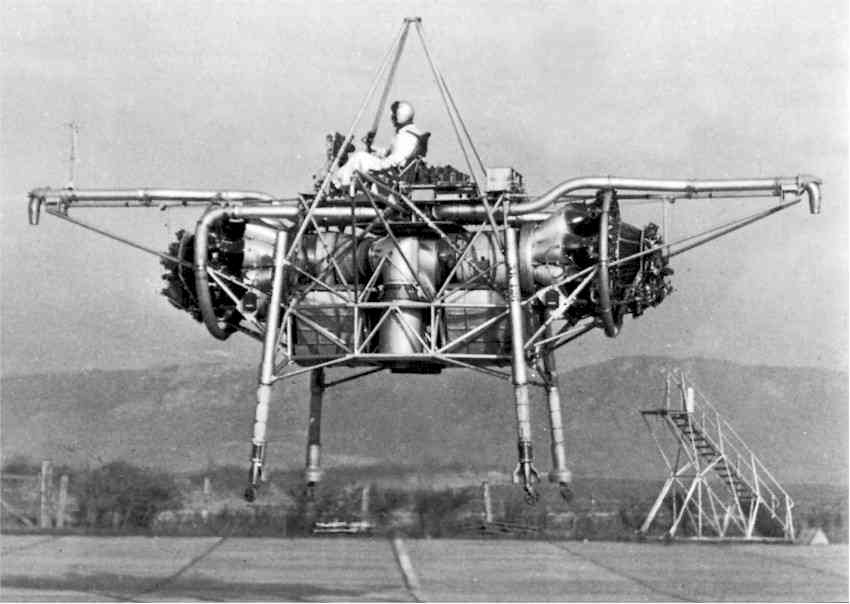
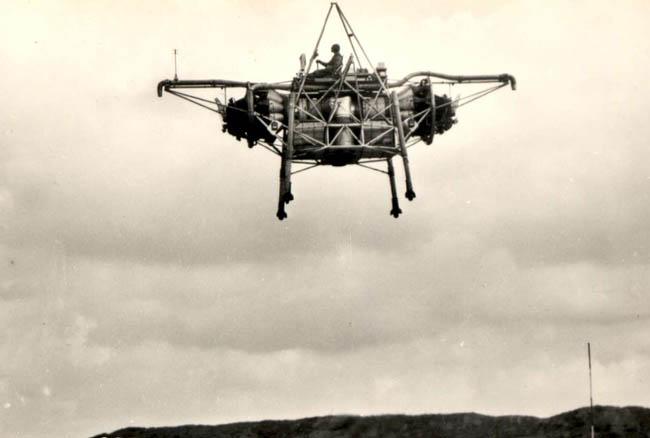 At 15 I left school, to work in the aero-engine labs : by that time WWII was over, and the factory was being run by Rolls-Royce.
At 15 I left school, to work in the aero-engine labs : by that time WWII was over, and the factory was being run by Rolls-Royce.
It was there that the first VTOL plane was developed - the "Flying Bedstead" - so called because that's what it looked like.
Then I moved to another company and worked on rocket fuels and design, on a team preparing for the first space shots and satellites. While I was working I also went to "Night School" at Burnley Tech., and entered for the London University B.Sc. external degree. I couldn't decide between Physics and Chemistry for a major, so ended up taking triple honours - Maths, Physics, and Chemistry.
See a 1954 film of the Flying Bedstead in action
A later account of Vertical take-off planes
![]()
After the B.Sc. I started straight in with doctoral research - not in metallurgy or fuel technology, which had been my areas up until then, but on some potential carcinogens.
I had wanted to take a medical degree, but Medical School cost more than I could afford, so trying to get into medical research was the next best thing.
The first step of a 26-step synthesis produced lovely chunky crystals, about which the books said "Discard the salt crystals." - So I dumped them in the sink and flushed them.
Funny - they didn't dissolve in water like salt crystals should.
Turned out the stuff wasn't salt at all, and I spent the next two years finding out what it was, and writing my doctoral thesis on it.
I found out that I also liked teaching - so I enrolled at the Teacher Training College, and got my Certificate of Education, with adult education as the emphasis
I continued with the Violin and Viola, but those were the days when hammering the fingers onto the string with strength rather than agility was emphasized. I developed tendonitis in the left hand and had to cut down on practicing, so I knew I'd never make it as a professional musician.
Some of my other hobbies and activities were acting and horse-riding. At Huddersfield I was part of the College drama group, and took part in the world-premier of a play which one of the English Department faculty wrote and produced. I spent one summer at the riding stables of Sybil Smith, the riding master for the Royal family. Because I can ride side-saddle, I got to work with Captain, the horse which Queen Elizabeth rode for the "Trooping of the Colours", and with Colleen, Princess Margaret's mare who was both a hunter and a dressage horse.
Visit :
Huddersfield University - formerly Huddersfield College of Advanced Technology |
Teacher Education at Huddersfield
![]()
After my doctorate I moved to Aberdeen University, in the north of Scotland, for three years of teaching and research on insect pigments. I met my first computers, and learned to program with 5-hole paper tape (edit it with a razor blade, sticky tape, and a steady hand), when a "short" program might well run for 27 hours ! Those were the days before BASIC - I'm ancient :-)
While at Aberdeen I played in the University orchestra, sang in King's College choir, started to learn Chinese and Japanese, took up ice-skating, and started on figure-skating and ice-dancing competitions
Visit : Aberdeen | Aberdeen University
![]()
I wanted to move into the newly opening field of Biophysics (this was before there was such a term as Molecular Biology) so I joined J. D. "Sage" Bernal's group at Birkbeck College of London University - in the labs where Rosalind Franklin had worked after she made the X-Ray photos used by Crick and Watson in the helix break-through for DNA. After her death, her research team, with Aaron Klug, Ken Holmes, and Reuben Leberman, was moved to Cambridge. This left a gap at Birkbeck - there were still crystallographers there, but no Biochemist, and it was that position for which I was interviewed. The interview took just about two sentences.
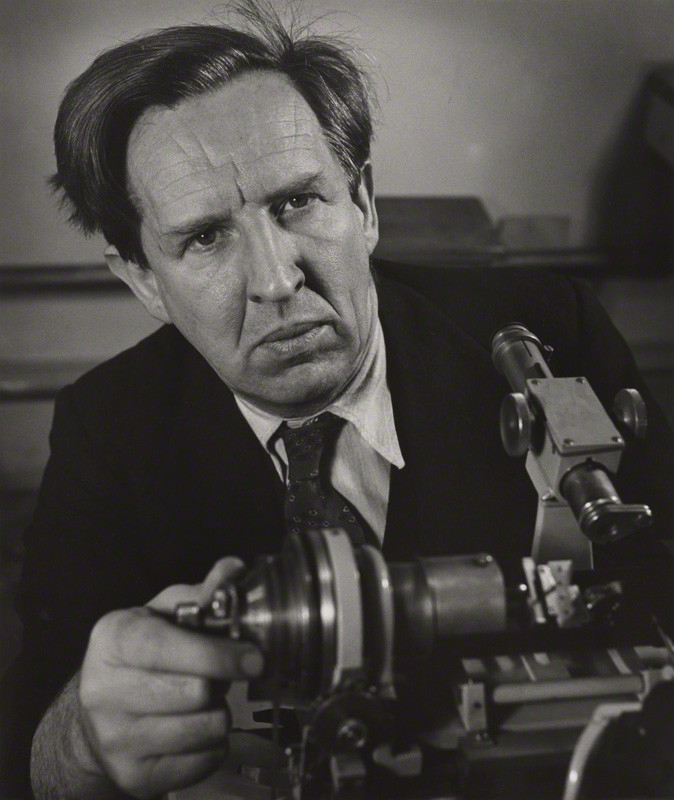 Bernal said "You realize that what we are trying to do is said to be impossible. What's you're reaction to that?"
Bernal said "You realize that what we are trying to do is said to be impossible. What's you're reaction to that?"
- Not at all the questions I'd been thinking he'd ask - nothing about my qualifications or my lack of Biochemistry or medical training.
All I could say was something like "Well, I need a challenge. If I work at something that's too easy, I do a sloppy job, and end up despising myself."
His reply was "OK, Harry" (Harry was one of the remaining crystallographers). - That was it - Interview over! Job mine!
I found that I had "green fingers" for growing crystals - for the Ribonuclease project, and for all sorts of biologicals for the doctoral and post-doc students.
I still managed to keep up the figure-skating - usually going to the rink at Bayswater for an hour's practice early every morning before going to work. I had got as far as the Bronze-medal for figure skating, when there was a devastating fire at the Lab. Putting the research back together in temporary labs in Birkbeck and University Colleges took priority, so skating, music, and riding all had to be put on hold. I'm a Life member of the British Skating Association, but I've never got back to serious skating again.
The fire started in the lab on the floor below mine, and burned completely through the floor of mine before it was put out. We rescued as much of the equipment and crystals as we could - it was scary to stand on a burned wooden floor, look down through the hole in the middle of the floor, and see two stories of blackened labs below us.
The labs were in three houses on a bomb-site. Most of the rest of the row had been completely blown up during the war, and those three remaining houses were rated as unfit for human occupation - so they'd been turned into labs!
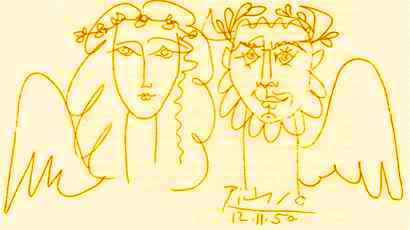 An added complication was that Sage Bernal had had an apartment at the top of one of the houses. He and Picasso were friends; one night they came back from a jaunt on the town, and Sage said to Picasso "Draw something!". So he drew a cartoon of two cherubs on the wall of the apartment - and it was the only Picasso mural in England. It survived the fire, and then some Art Conservation society wanted to have it moved to a museum. It meant cutting the whole wall out, so I had to work round that too.
An added complication was that Sage Bernal had had an apartment at the top of one of the houses. He and Picasso were friends; one night they came back from a jaunt on the town, and Sage said to Picasso "Draw something!". So he drew a cartoon of two cherubs on the wall of the apartment - and it was the only Picasso mural in England. It survived the fire, and then some Art Conservation society wanted to have it moved to a museum. It meant cutting the whole wall out, so I had to work round that too.
It was at the time of the fire that I got to know Francis Crick better. He was at the MRC (Medical Research Council) Labs in Cambridge, and came up to London for a meeting, where he heard about the fire at Birkbeck.
He came over immediately to say he was sorry to hear of it, and could he help with anything.
I'd been about to ask if he could take on one of the doctoral students and give him lab space at Cambridge, when dear Harry cut in with "Dr. Morris has everything under control thank you!" in tones that said Get Out and Go Away.
(My name was Morris at that time. I am seldom at a loss for words, but I certainly was then)
I stayed on at Birkbeck, and we did eventually publish a low-resolution map of Ribonuclease, but there was quite a difference in personality and methods of working between myself and the immediate head of the team. At one point some of us even discussed putting an advert. in "Nature" saying "Protein Crystallography Team seeks new Leader. Have diffractometer. Will travel."
Visit : Birkbeck | London University
![]()
Then I was invited to an International Biophysics Meeting in Vienna - Sage was supposed to give the Keynote Address, but he was too frail after a heart-attack, so John Kendrew said he'd read Sage's talk, and I'd look after the slides and the rest of the things that needed doing. It was at that meeting that someone asked me where I was working, and when I replied "At Birkbeck, with Dr. . .. " one of the other scientists there said loudly "That's the first time I've heard of anyone working with . . . - they're usually working in spite of him." - and everybody laughed as if they knew what he meant!
I honestly did try to change the subject - I'm not in favor of telling tales on fellow-workers. However, Ken Holmes came over and said quietly "Hang in for two years, and when I go to Heidelberg, there'll be a place for you there." He had just been asked to head up the Biophysics Department at the Max Planck Institut for Medical Research in Heidelberg, and was starting to choose his team.
![]()
As part of the preparation for the research in Heidelberg, I moved to the MRC Labs in Cambridge, to crystallize t-RNA for X-Ray studies. I still remember the weekend when I fished a dripping photo out of the final rinse, saw the pattern of spots with a nice distinctive "Helix Cross", and knew that I had true crystals of a Nucleic Acid - the first in the world ! The only others around the lab that day were Aaron Klug, John Finch, Francis Crick and myself - we had a party in Aaron's office.
 t-RNA and I moved as part of Ken Holmes' Biophysics team to the Max Planck Institute for Medical Research in Heidelberg, and for the next 9 years I played with nucleic acids and proteins, TMV and other viruses, X-Ray Crystallography, Electron Microscopy, sequencing, and all the other toys of what is now called Molecular Biology.
t-RNA and I moved as part of Ken Holmes' Biophysics team to the Max Planck Institute for Medical Research in Heidelberg, and for the next 9 years I played with nucleic acids and proteins, TMV and other viruses, X-Ray Crystallography, Electron Microscopy, sequencing, and all the other toys of what is now called Molecular Biology.
Visit :
The MRC |
MPI for Medical Research, Heidelberg |
Viruses, Crystals, and Geodesic Domes
You Tube Videos :
Rosalind Franklin |
Rosalind Franklin |
Photo 51
![]()
While in Heidelberg, I helped to start the "English Church" - now part of a team with churches in Stuttgart and Strasbourg. It was in that Church that John and I met, and got to know one another. The army intervened, and moved John back to the Pentagon, and we both agreed that it had been nice knowing one another, but that we both had careers to get on with.
Well, for several years we kept in touch by mail, until the mailman in the village where I lived would hand me my mail with a twinkle in his eye, saying "Einen Brief aus Amerika - fur Sie!" (A letter from America - for *you*).
I explored the possibility that God was calling me to be a nun with the Marienschwestern in Darmstadt, but came to the conclusion that my calling was to stay "in the world".
Visit : The Marienschestern
![]()
To cut a long and involved story short, John and I decided to get married, so I resigned from the MPI and came to the States on a "Fiancee Visa", which came through only about two weeks before the date we'd set for the wedding. John stayed in the military for another 2 years, to complete his 20, then we moved to Ambridge, PA, to attend TESM (Trinity Episcopal School for Ministry), and John entered the process towards ordination in the Diocese of San Joaquin in the central valley of California.
We spent the next 5 years commuting between Pennsylvania and California : winter and spring at TESM, summers working at various churches in the Diocese. We both completed the M.Div., and John was ordained Deacon, and then Priest, at the Mission Church of the Resurrection, in Clovis, California.
Visit : St. Paul's, K Street (Washington DC) where we were married | TESM
![]()
We had some wonderful years in California, seeing the Mission grow, working Cursillos, and making friends at the Hispanic, Hmong, and Lao Missions. I started to learn Hmong, mainly with the children of the community, who would sit on the church steps with me and laugh with delight as I tried to get the tones of the language - "child's play" to them, but something the western ear and voice have to work at.
We found a beautiful home, on 2 acres of land, a few miles out of town, where I could look out of the kitchen window, over our neighbour's kiwi orchard and an orange grove, at the snow on the Sierra Nevadas. We had chickens, ducks, cats, goats, sheep (solar-powered lawn-mowers : the sun comes out and the sheep start chomping), and I got to be quite good at building fences and gates, putting in irrigation lines, looking after the well, and planting young trees for the orchard.
I kept up with Academics, by teaching Physics and Chemistry part-time at FSU (Fresno State University) and at West Coast Christian College - where I taught Science, Maths, Greek, and Hebrew.
![]()
Then came the memorable day when we had a phone call from someone we'd never met, and had never even heard of, asking if we'd move to Houston, Texas, for John to be the Assistant at St. Thomas' Church and school there. The circumstances were so completely unexpected and strange, that I knew we were going to move, even before John had finished the phone conversation. So, within a few weeks, a new Pastor was found for the Mission, and John moved to Houston. I stayed on to finish out my contract with FSU, and to pack up our books and sell the house.
So off to Houston, where I had to learn to live with Texas-sized mosquitos.
For the next several years, John was the Assistant Pastor at St. Thomas', and I was a Chaplain at Ben Taub Hospital, the main Trauma Center and Charity Hospital in Houston. I did several units of CPE (Clinical Pastoral Education) at Ben Taub, and often got the Friday evening to Saturday morning shift - with an unending stream of GSWs, AgAss, MVAs, Rapes, drug overdoses, and assorted stuff that had to be experienced to be believed. Even a gun battle in the ER Waiting Room. (GSW = gun shot wound; AgAss = Aggravated Assault; MVA = motor vehicle accident)
![]()
Time came for another move, when the people of St. James', Clovis, asked John to come and be Rector, which included having the oversight of the Missions of the High Plains' Team, with churches in Portales, Tucumcari, and Fort Sumner. We settled down in Clovis, and I joined the Symphony Orchestra at ENMU in Portales, taking up the Viola again after 30 years.
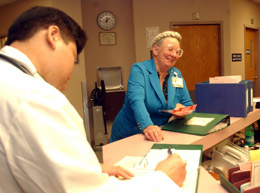 In Clovis, I taught Science and Math in the new Christian School, and Chemistry at the Community College, then decided to get back to music more seriously, so I enrolled as a Music student at ENMU (at Bachelor's level again), having to start with basic theory and aural skills, aiming for a degree in Church Music. I got to learn a whole lot of instruments - Handbells, Guitar, Piano, Organ, Viola, Violin, Bass, Voice - even a brief introduction to steel drums, - not all of them all at once - I don't have enough time for all the practice !
In Clovis, I taught Science and Math in the new Christian School, and Chemistry at the Community College, then decided to get back to music more seriously, so I enrolled as a Music student at ENMU (at Bachelor's level again), having to start with basic theory and aural skills, aiming for a degree in Church Music. I got to learn a whole lot of instruments - Handbells, Guitar, Piano, Organ, Viola, Violin, Bass, Voice - even a brief introduction to steel drums, - not all of them all at once - I don't have enough time for all the practice !
 Also continuing with Viola in the Symphony Orchestra and another small string group, and singing in operas and other productions with the Music Department. Ten years later I finally walked across the stage to receive my Bachelor's degree in Music.
Also continuing with Viola in the Symphony Orchestra and another small string group, and singing in operas and other productions with the Music Department. Ten years later I finally walked across the stage to receive my Bachelor's degree in Music.
![]()
For one of the music courses I did a study of Liturgy and Music, for which my professor said: "Get on the Internet and find some resources."
In spite of having played with mainframes for years, and also PCs for quite a while, would you believe I'd never hooked up a modem, or used e-mail, or got on the Net? Well, students at ENMU get free access to some good labs full of terminals, so I went to the Computer Labs, asked for an orientation, and jumped right in. For "Music Resources" I found not only the Spanish hymns for which I was searching, but also a bunch of Musician Jokes (and much more) - and got an "A" for that course.
Then I found out how to get a Web Page, and started the prototype of this one (but on the Geocities freebie site), and things just kept on going from there.
![]()
In 1999 I was appointed as one of the Religion Professors at ENMU, and now run Online Courses, where the students take the whole course via the InterNet. It's good to get back to teaching again - Greek and Bible courses, and the occasional seminar for Churches on Web Page authoring.
Then I was elected Chair of the Religion Department - so life became even busier. I retired as Chair some years ago, but stayed on to continue teaching.
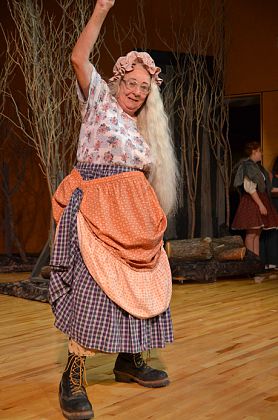 I also kept up with music and acting - playing the Witch in "Hansel and Gretel", the Mother Superior in "Sister Angelica", and Little Red's grandmother in "Into the Woods".
I also kept up with music and acting - playing the Witch in "Hansel and Gretel", the Mother Superior in "Sister Angelica", and Little Red's grandmother in "Into the Woods".
For some years I taught Greek from a variety of textbooks, but most of them were either rather dry grammar, or else were too dumbed-down. I want my students to enjoy learning to read the Greek New Testament, and do so with understanding. Eventually I got tired of writing extra handouts for my classes, and wrote my
own Greek Textbook which is now available for free for anyone who wants it.
Visit : ENMU
Copyright © 1996 Shirley J. Rollinson, all Rights Reserved